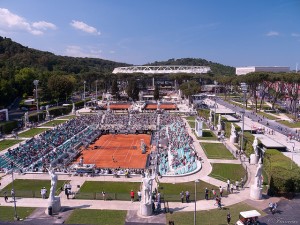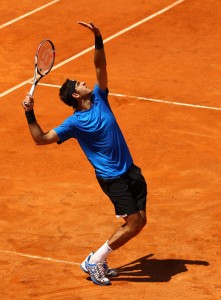Rome Masters, Second Round
Of the nine Masters Series events that liberally pepper each tennis season, Rome’s Internazionali BNL d’Italia is my favourite. I was recently asked to explain this preference, and came up with, in no particular order: the crowd, the setting, the pacing, the courts, the standard of play, the light, the history, and the vibe. What can one hope to take from that?
The kitsch, grand Foro Italico is a decent place to start, if only for a laugh, and to register the cosmic irony by which fascism’s determination to legitimate itself architecturally is so rapidly undone when empires fail to last the distance. There are several ways this can come about. Hitler’s brief to Albert Speer was that the grandest Nazi structures – Nuremburg’s Zeppelinfeld is the exemplar – should achieve a rich afterlife as ruins once the Tausendjähriges Reich had run its course. A millennium proved to be a trifle ambitious, even for Hitler, and the short years since have demonstrated that whatever Speer’s gifts, guaranteeing eternal grandeur wasn’t among them. (Arguably his greatest gift was to escape prosecution.  He didn’t get away with murder, but he did get away with hanging out with a lot of murderers, and his primary defence consisted of disingenuousness, and later, doddering.) His structures have not passed time’s test, and I suppose the writing was on the virtual wall, etched with shadow, when his most inspired creation – the haunting Lichtdom – only lasted a night.
He didn’t get away with murder, but he did get away with hanging out with a lot of murderers, and his primary defence consisted of disingenuousness, and later, doddering.) His structures have not passed time’s test, and I suppose the writing was on the virtual wall, etched with shadow, when his most inspired creation – the haunting Lichtdom – only lasted a night.
Mussolini’s Foro Italico isn’t like that. Firstly, rather than seeking to connect itself to an imaginary and vehemently advertised future, it sought legitimacy through an alignment with Eternal Rome. However, thanks largely the presiding ego of Il Duce, the alignment feels skewed. It doesn’t feel like you’re in ancient Rome. It feels, again ironically, more like a movie set. Secondly, it was always conceived as a sports complex, and has, to my knowledge, never stopped being one. Irreversible traducement occurs when a structure is repurposed into irrelevancy – again, look to Speer – but the Foro Italico escaped this fate. It hosted the 1960 Summer Olympics. It now houses the Rome Masters. Yet the irony remains. For all that it apes antiquity, the fact is that there are ‘Roman’ villas in Los Angeles that are older than the Foro Italico, and crafted with greater attention to period detail. Just because it’s in Rome doesn’t mean it isn’t ridiculous. But just because it’s ridiculous doesn’t mean it’s not fantastic.
There is also the danger – or, let’s be honest, the certainty – that this irony will evaporate. Already the process is under way, as all historical epochs beyond living memory collapse in on each other. Borges reminds us that the structural discord underlying Don Quixote is now lost to us, pointing out that the allegedly dull world of Cervantes’ Spain has since grown as poetic as the romances that once scrambled the Don’s brain. The book derived its force from an irony we can no longer feel. The Foro Italico, for all that it is barely 80 years old, now evokes a mighty Roman past, especially in the crucible of sporting combat, when the essential distinction readily melts away. I’ve stood and laughed at the absurd statues ringing the grounds, but the 2006 Rome final ranks among my favourite matches, and it only gained from the setting.  It was viciously gladiatorial – as was the 2005 final – and the venue was marvellously conducive to this, for all that it has hosted as many real gladiators as the Caja Magica. Sport, like all good drama, requires the suspension of disbelief, and set-dressing as lavish as the Foro Italico permits tennis to transcend itself.
It was viciously gladiatorial – as was the 2005 final – and the venue was marvellously conducive to this, for all that it has hosted as many real gladiators as the Caja Magica. Sport, like all good drama, requires the suspension of disbelief, and set-dressing as lavish as the Foro Italico permits tennis to transcend itself.
Of course, the new Court Centrale – which I have never visited – doesn’t boast the same cachet, although it looks quite good on my television screen. The old centre court had already been renamed in honour of two-time Italian Open champion Nicola Pietrangeli, and now serves as the third court. It will no longer witness great finals, although today it inspired former champion Juan Carlos Ferrero to stage multiple comebacks in defeating Gael Monfils. This reminds me that whatever the benefits of the venue, the main reason I love the Rome Masters is the tennis. It just has a habit of staging excellent matches.
(10) Del Potro d. Llodra, 7/5 3/6 6/4
There was never much chance that Michael Llodra could beat Juan Martin del Potro today. He grabbed a set off the Argentine back in Rotterdam, but that is a fast indoor court. Rome is bona fide clay, Llodra is authentically 31, and del Potro really is much better at tennis. Unsurprisingly, I can barely recall the Frenchman winning a point from the baseline, until the last games. Until that moment, it was a classic contrast in styles, with Llodra hurtling towards the net, and del Potro either belting a passing shot or grudgingly admiring his opponent’s volleying prowess.  Llodra had the first set point in the first set, but del Potro had the last one. Llodra, with almost no backhand, took the second, still galloping forward. There appeared to be something wrong with Del Potro’s knee. He broke in the third, and moved to 30-0 at 5/3. Llodra produced four great points from nowhere to break back.
Llodra had the first set point in the first set, but del Potro had the last one. Llodra, with almost no backhand, took the second, still galloping forward. There appeared to be something wrong with Del Potro’s knee. He broke in the third, and moved to 30-0 at 5/3. Llodra produced four great points from nowhere to break back.
Having momentarily averted defeat, Llodra commenced a tirade at the umpire at the changeover, which wasn’t precisely what the situation called for, although it was an improvement over hurling racial epithets into the crowd. ‘Apologies for the colourful language, folks’ offered Robbie Koenig. Jason Goodall isn’t in Rome this week, and his absence was suddenly apparent. You just know he would have rejoined with some variation on ‘Pardon my French, or not’. Chris Wilkinson wasn’t quite up to it. You know you’re fan when you begin idly composing routines for them during a highly entertaining tennis match. Del Potro, desperate, was tumbling all over the court by this stage. Caked in clay, he sealed the match with a pair of enormous returns past the incoming Llodra.
In other fine matches, Andy Murray and David Nalbandian gradually got around to producing a classic backhand duel, one that ultimately hinged on a dead net-cord deep in the third, while Lukasz Kubot played with typical flair and aggression to finally beat Potito Starace. The latter was lucky to get a set, although it was worth it since it delayed Murray’s appearance on court, thereby sending the British pundits spare.

4 Responses to Lavish Set Dressing